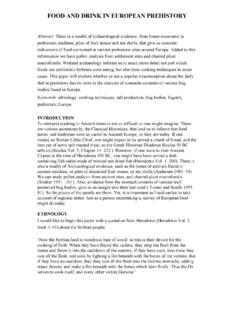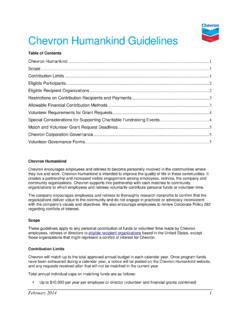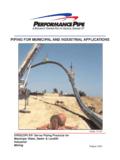Transcription of Jacqui Wood
1 THE ORKNEYHOOD AN ANCIENTRE- CYCLED TEXTILEbyJacqui WoodIn St. Andrew s parish Orkney in 1867 a garment was found in a peat bog, which was subsequently named The Orkney hood ( illus 1 ). This apparently unique garment with its complex weaving and double tabletwoven bands with fringe, was taken to the National Museum of Scotland in Edinburgh for display. The hoodremained on display for approximately 83 years until it was studied in detail byA .S. Henshall, (Henshall 1951-52, 9) in this report it was suggested that the hood could be of Iron Age orViking origin due to the tablet woven bands which were a typical feature of Scandinavian textiles of theseperiods. It was also suggested by Henshall that the style of the fringing on the hood could have its origins inBronze Age Danish Textiles. A recent report on the Orkney hood (Gabra-Sanders 2001, 98 ) also comes to thisconclusion. These suggestions are references to the Egtved corded skirt (Broholm and Hald 1948, 30 ).However the Egtved skirt which I have replicated in the past, is made of an entirely different technique.
2 Thisskirt was made of a twisted wool fringe, which was interlinked at the hem, the fringe was not free falling asthe hood fringe was. The cord also issued from a plain tabby woven band and not from a tablet woven band asthe fringing on the Orkney hood . Therefore it does not in any way relate to the techniques used in the manu-facture of the hood and should not I feel be compared with was commissioned to make a replica of the Orkney hood following a lecture I gave on Experimental archaeology in the 21stcentury at the Seachange conference in Orkney, September 2001. Thispaper will reveal the conclusions and discoveries I made while manufacturing the replica hood for display atthe Minehowe Know How event in Orkney May 2002. The first prerequisite prior to making the replica was tofind out what type of wool it was made of and if it had been dyed to produce the two tone brown and goldenshades of the original. In 1981 the hood was taken to the Conservation and Research Laboratories of theNational Museum of Antiquaries of Scotland for full conservation treatment.
3 The subsequent analysis prior toconservation ascertained that the wool had not been dyed (Findlay 1981, 95) and that the brown colourationcame as a result of pigments in the fibres, indicating that it came from moorit sheep (naturally brown fleeces).Also preceding conservation a radiocarbon date was obtained of 1595+BP AD c 250-615 which essentiallyconfirms Henshall s suggestion that the textile had an Iron Age date. Ryder in his essay on the evolutionof sheep breeds (Ryder 1968, 139) suggests that the wool used to manufacture the hood was of a hairy medi-um, fine type of fleece very similar to that of Shetland sheep fleeces. Coloured Shetland sheep are relativelycommon in my home county of Cornwall this made the task of finding the raw materials for the hood compar-atively easy. However when studying photographs of the hood I noticed that the majority of the textile had avery distinctive golden hue to it. I therefore proceeded to my local Wool Marketing Board wool sheds andacquired as large a colour range of Shetland fleeces as I could find, eight in all from Black to a Pale Apricot.
4 Itravelled the following week to Edinburgh to study the hood first hand at the National Museum of Scotland,armed with sixteen switches of fleece (two from each fleece one from the top and one from the bottom). At themuseum I was given a desk in the office and the hood to scrutinize for the day. The main part of the hood waslighter and yet a more vibrant golden colour than I had ascertained from photographs I had studied. In reality itwas exactly the same as the sun bleached tips of the mid brown fleece I had brought with me. The naturalcolour of sheep wool bleaches with the sun during the summer, this bleaching effect continues when it is madeinto textiles too. Very much the same as an old faded woollen blanket does. This suggests that the main part ofthe hood was originally a mid brown and paled down with age to the rich golden colour it is today. Thishypothesis was given weight when I tried to match the dark brown bands in the tablet weaving. The tips of theblack fleece were almost exactly the same as the dark brown colour on the original.
5 Therefore I suggest thatthe original hood was made of dark brown Shetland fleece with Black Shetland fleece stripes in it. Armed witha days measurements and innumerable photographs I left Edinburgh for Cornwall to begin my LoomThe first job I needed to do before I could begin to make a replica of the hood was to make a simple warpweighted loom. The simplest method of loom construction is to select two forked trees for the main uprightsapprox 11 cm diameter and 180 cm long. Three straight branches are also required one to slot between the twoforked trees and the other two to be lashed approx 40 cm from the base to stabilize the loom. This type ofloom can be made in a morning and warping the loom can proceed in the afternoon. A series of 3 cm holes arethen required half way down the forked uprights to peg in the forks to lift some of the sheds. This was donewith the aid of a modern electric drill but I have in the past drilled these holes with primitive push drills thelatter takes about 15 minutes per hole.
6 Two small forked branches 3 cm thick and 20 cm long are needed topeg into the holes in the uprights. Finally three straight sticks of hazel are required, two for the sheds and theother stick to hang from the top of the loom. The latter will be bound tightly with string to separate the warpthreads and keep them apart during the weaving process. Now the loom structure is complete apart from themanufacture of the round clay weights to hold the warp threads taut. Taking my measurements from Henshall s report in the 1950 s the woven fabric was approximately 49 cm x45 cm and was cut from a larger piece of cloth as there were no selvages evident. This led Henshall to suggestthat although no selvedge remains there is no doubt which set of threads is the warp, for a gore occurs at A onthe plan, and irregularity which can only be formed in the weft. (Henshall 1951, 10). This suppositionalthough valid when studying the garment led me down a path which took at least a month of frustrated effortsto find it was inaccurate, I will describe this in detail later in this paper.
7 My measurements of the hoodrevealed that 10 warp threads per cm were needed so as to give myself a little cloth on each side I would need540 mm single z spun threads to warp the loom. Shetland wool is very easy to spin this fine, howeverwhen required for a single spun warp thread it needs to be very tightly spun in order to take the wear of thesheds and the pull of the previous experience when using a warp weighted looms was not with such fine warp threads. This led onto an interesting conclusion, which will undoubtedly improve my weaving proficiency in the future. As a ruleone ties bundles of the warp threads through the holes in the loom weights. Due to the fineness of this yarnand amount of warp threads required, as the warp threads were tied through the weights they could not fallfreely and tended to rest upon each other thereby not applying the necessary tautness needed for the weavingprocess. The only method that would keep the weight distributed evenly was to push a stick through the holesin the weights and tie the warp threads to the stick either side of the weights.
8 This was an exceedingly superiorway to warp a loom as when extra weight is needed during the weaving process as is often the case, weightscan easily be added to the sticks ( illus 2 ).The Woven ClothThe cloth of the hood was a 2/2 herringbone twill weave with very erratic widths of the chevron widths ranged from 18 warp threads per stripe to 88 warp threads. This is very unusual as the chevronstripes in 2/2 twill weaves in the iron age period are customarily even. In a study of woven fabrics and theirconstruction in Danish Iron Age textiles Margaret Hald observes: 2/2 twill is the most usual form of twill. A weft thread passes alternately over two and under two warpthreads, with the result that the right side and the reverse side of the fabric is similar. The points of intersectionare not as close as tabby, therefore a twill fabric is softer and more comfortable - an advantage which probablycontributed towards the change in the Bronze Age from Tabby to twill The simpler variations oftwill are made by changing the direction of the diagonals.
9 Shifting the points of intersection so that horizontalzig zag lines are made produces the weave called pointed twill. (Hald 1980, 148)Hald goes on to describe twill pattern variations but in all instances the zig zag patterns are surmised in her research the warp threads were single threads and the weft threads were fine andused double, in other words each horizontal thread was made up of two fine threads used together. Also shesuggests that the chevrons ran horizontally across the loom in a very uneven zig zag began to thread the loom using this assumption. A 2/2 twill weave requires four different sheds to form thetwill weave pattern. Therefore I had to calculate which warp threads should be attached to the four shedsincorporating the uneven chevrons into the calculations. I really did not think this would be a problem until Iactually tried to do it. It is important I feel at this stage of my report to detail just how uneven the chevronstripes were. These numbers are the warp threads per stripe each time they changed the direction of the stripe:18, 18, 28, 24, 18, 38, 42, 26, 22, 88, 26, 26, and 18.
10 It took about two days or 16 hours to thread the loombefore I could start weaving. After twelve rows of weaving the pattern appeared to be working, until I inspect-ed the reverse side of the cloth and discovered innumerable loose threads forming loops at the change in thechevron stripes. So I unpicked the weaving and started to re-thread the sheds again because the cloth was a2/2 twill weave the whole loom had to be re threaded again another two days work. I did in fact re thread andstart weaving the loom for 48 hours trying every conceivable method I could think of to accommodate theuneven chevron stripes. The only feasible conclusion I came to was that it could not be done with the zig zagstripes horizontal. The only other way to try it was to treat the single warp threads as weft threads and the dou-ble fine weft threads as warps. So I re threaded the loom again using double fine threads as one, which workedvery well although the two threads were not plyed together, they were just a strong as if they were plied.






